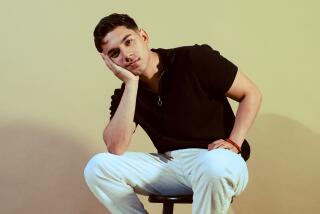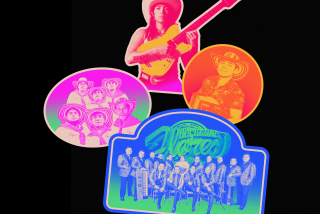Bassist was father of mambo style
- Share via
Israel “Cachao” Lopez, the Cuban bassist and composer who is credited with pioneering the mambo style of music, died Saturday at a Miami-area hospital. He was 89.
Known simply as Cachao, the Grammy-winning musician had fallen ill last week and died surrounded by family members at Coral Gables Hospital, spokesman Nelson Albareda said.
Cuban American actor Andy Garcia, who made a 1993 documentary about the bassist’s career, credited Cachao with being a major influence in Cuban musical history and said his passing marked the end of an era.
“Cachao is our musical father. He is revered by all who have come in contact with him and his music,” Garcia said in a statement Saturday. “Maestro . . . you have been my teacher, and you took me in like a son. So I will continue to rejoice with your music and carry our traditions wherever I go, in your honor.”
Cachao (ka-CHAH-o) and his late brother, multi-instrumentalist Orestes “Macho” Lopez, are known for the creation in the late 1930s of the mambo, which emerged from their improvisational work in Cuba with the danzon, an elegant musical style that lends itself to slow dancing.
“We would take turns at the piano and try things out,” Cachao said in a 1995 interview with the Miami Herald. “And that’s how things came up. We realized then that this rhythm was not common. And it was faster than it is today. . . . But it was too fast for dancing, and we were six months without any work. People didn’t like it. When we slowed it down, then it became danceable.”
The mambo, with its sped-up syncopation, was popularized by bandleader Damaso Perez Prado, and Cuban composers and jazz musicians have tweaked it over the years. It also influenced the development of salsa music, a New York hybrid with Cuban roots.
In the 1950s, Cachao and his friends began popularizing the descarga (“discharge” in Spanish), a raucous jam session incorporating elements of jazz and Afro-Cuban musical approaches.
Cachao left communist Cuba in 1962, relocating first to Spain, and soon afterward went to New York, where he was hired to perform at the Palladium nightclub with the leading Latin bands.
In the United States, he collaborated with Latin music stars, including Tito Puente, TitoRodriguez, Machito, Chico O’Farrill, Eddie Palmieri and Gloria Estefan.
He lived in Las Vegas in the 1970s, performing at casino shows, but eventually had to leave.
“If you live in Las Vegas and gamble, you spend most of your time at the pawnshop,” he told the Miami Herald in 1995. “I have to thank my wife Esther; if not for her, we would not have anything. But I had to quit and I did, cold turkey.”
He fell into obscurity during the 1980s after moving to Miami, where he ended up playing in small clubs and for weddings.
But his career enjoyed a revival in the 1990s with the help of Garcia’s documentary “Cachao . . . Como Su Ritmo No Hay Dos” (Like His Rhythm There Is No Other) and the release of several CDs, including the Grammy-winning album “Ahora Si!” in 2004.
Cachao was born in Havana in 1918, the youngest of three children whose parents played and taught the bass. The family of musicians at one point had 35 bassists in its circle. “Our house was a wreck, with instruments everywhere,” Cachao told the New York Times in 1991. “There were people playing all the time.”
Classically trained, he began working professionally at age 8, playing with the house orchestra of a movie theater, providing background music for silent films.
He stood on a wooden crate to reach the upper neck of the stand-up bass.
Cachao began performing with the Havana Philharmonic Orchestra as a teenager, working under the baton of visiting guest conductors including Herbert von Karajan, Igor Stravinsky and Heitor Villa-Lobos during his nearly 30-year career with the symphony.
He also wrote hundreds of songs in Cuba for bands and orchestras, many based on the classic Cuban music style known as son.
He continued to perform into his 80s. He appeared at the Hollywood Bowl in 2006, and in 2000 he performed a new composition called “Mambo Mass” at St. Vincent de Paul Catholic Church in Los Angeles.
Cachao, whose wife died in 2004, is survived by a daughter and a grandson.
“I’m a musician. That’s what I do,” Cachao told the Miami Herald. “I never had delusions of grandeur. I never expected to be famous or anything like that. I just played, and whatever happened happened.”
--
More to Read
The biggest entertainment stories
Get our big stories about Hollywood, film, television, music, arts, culture and more right in your inbox as soon as they publish.
You may occasionally receive promotional content from the Los Angeles Times.










